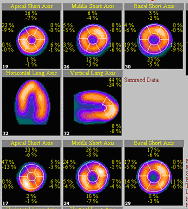
Here's an interesting example of a 71-year old man who achieved "reversal" of an abnormality by a nuclear stress test.
This man underwent bypass surgery around 10 years ago, two stents three years ago. A nuclear stress test in April, 2005 showed an area of poor blood flow in the front of the heart. On the images, normal blood flow is shown by the yellow/orange areas. poor or absent blood flow is shown by the blue/purple areas within the white outline.
Now, I can tell you that this man is no paragon of health. He's only accepted limited changes in his otherwise conventional program--in other words, someone who I'd be shocked achieved true reversal of his heart disease. (I didn't have him undergo any CT heart scans because of the difficulties in scoring someone who has undergone bypass surgery and stents, and because of limited motivation. True plaque reversal is for the motivated.)This patient did, however, accept adding fish oil and niacin to his program.
Nonetheless, stress testing can be helpful as a "safety check". Here's the follow-up stress test: 
You'll notice that the blue/purple areas of poor blood flow have just about disappeared. This occurred without procedures.
Does this represent "reversal"? No, it does not. It does represent reversal of this phenomenon of poor flow. It does not represent reversal of the plaque lining the artery wall. That's because improvement of flow , as in this man, can be achieved with relatively easy efforts, e.g., improvement in diet, statin drugs, blood pressure control, etc. True reversal or reduction of coronary plaque, however, is tougher.
If blood flow is improved, who cares whether plaque shrinks? Does it still matter? It does. That's because the "event" that gets us in trouble is not progressive reduction in blood flow, but "rupture" of a plaque. A reduction in plaque--genuine reversal--is what slashes risk of plaque rupture.